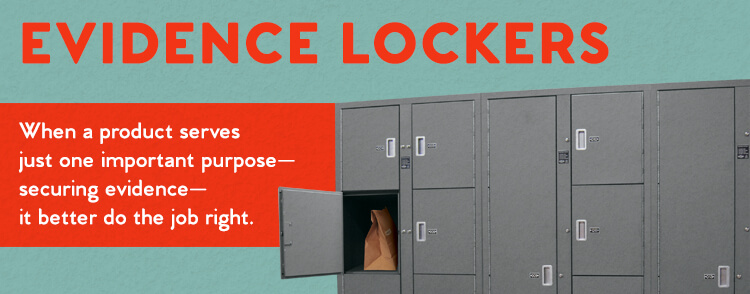CHALLENGER INSIGHTS Vol. 16:
Evidence Lockers—Being Different, Being Better

Nothing pains me like seeing a specification written around a competitor’s evidence locker. When I meet departments who are looking for temporary evidence storage, I always ask, “What exactly do you need a temporary evidence locker to do?” The answer is usually, “We need it to secure evidence until the technician or custodian can log the evidence and store it long term.”
That answer might seem obvious, but when a product serves just one important purpose—securing evidence—it better do the job right. Our evidence lockers do that job better than our top competitors—and when I come up against competition, I have 4 go-to differentiators that help me win the sale.
At IACP last fall, we met many departments who were undergoing state accreditation and trying to decide what type of temporary evidence lockers would best secure their chain of custody. The problem? Many times, their architects and contractors were specifying the cheapest available evidence locker without considering what the police departments were losing in security as a consequence.
The strongest tool you have when you come up against evidence locker competitors is teaching differentiation. Here are some of the most important—and lesser known—features to point out that can help seal the deal on a locker sale.
1. Latching and Anti-Pry
Our top two competitors have single point latching for their evidence locker compartment doors, whereas Spacesaver uses two latching points with an anti-pry tab between the two latch points. It’s important to point out this difference and teach customers how it can prevent evidence theft and tampering.
2. Ease of Use
To be effective, the evidence locker has to be easy for officers and technicians to use. With a simple push of a button, an officer can hear the “clunk” of the lock engaging, assuring them that the locker is secured. No handles for officers to turn, no keys for officers to lose. Our top competitors use a slam shut locker that remains open until evidence is stored and latches when the door is closed. It sounds simple until someone shuts all of the doors.
3. Latching Mechanism Placement
What you don’t see inside the compartment is what’s important. Spacesaver’s latching mechanism is fully enclosed within the walls of the evidence locker. Competitors have the mechanism installed inside the compartment. This means that when evidence is jammed in the compartment, the obstruction from the latch can damage packaging, damage the evidence or damage the latch. Tiffin recently started adding a metal cover for the latch. Perhaps they caught on to the issue, but the compartments still have the obstruction.
4. Welding and Durability
Look at the durability of the locker itself. Spacesaver has a welded locker with continuous stainless steel hinges. Most of our competitors mix and match with welding and cut corners with rivets. Rivets can allow the joined pieces to move. If your latch mechanism requires alignment for slam shut latching, then the latches must align in order for the door to shut. Any shifting that occurs during shipping or in leveling the cabinet may cause movement, which affects the alignment of latches.
The important takeaway is to find these opportunities early, and teach the differences. If you have an install in the area, have a customer share product differences during a site visit.
What are your go-to differentiators that have helped you win sales? Have you found other features that set our evidence lockers apart?
Email McKenna Dustman at mdustman@spacesaver.com to give her your insights.